Abstract
The concentrated photovoltaic/thermal system (CPVT) adopting spectral beam splitting is a promising field of solar energy research. However, the thermo-electric properties of fluid-based CPVT collectors, which depend strongly on the non-uniform concentrated energy flux, remain unclear. This study aims to fill the gap and explore the thermo-electric properties of fluid-based CPVT collectors under non-uniform energy flux based on the finite volume method (FVM) with the Monte Carlo Ray-Trace (MCRT) method. The actual solar flux distribution on the receiver surface is obtained using Tracepro software. Then, the realistic non-uniform energy flux was employed in ANSYS Workbench 2022R1 software as a boundary condition to increase the accuracy of the CFD modeling of the system. The model is validated by comparing the results of the reference data. Moreover, the impact of uniform and non-uniform energy flux on the PV cell temperature is analyzed. In addition, the effects of mass flow rate on the electrical and thermal performance of the system are investigated. The results show that the PVT hybrid system has high conversion efficiency, with a total efficiency of more than 50%. Notably, the extreme non-uniformity of the solar-concentrated energy flux can result in local overheating of the PV cell, which may lead to irreversible damage.
1. Introduction
Against the depletion of traditional energy sources, humanity is constantly looking for alternatives to conventional fossil energy sources to alleviate the energy crisis. Under these circumstances, various new energy sources, such as solar, wind, tidal, and geothermal, begin to emerge. The development and utilization of renewable energy have become the focus of attention today. Among the numerous renewable energy sources, solar energy is considered one of the most promising energy sources due to its abundant reserves, wide distribution, and clean and pollution-free characteristics. There are 3.85 × 1024 J of radiation quantities to the earth’s surface per year, and only the portions of 0.5 h could provide the needs of the global energy demand for a whole year. Accordingly, the efficient utilization technology of solar energy has a broad development perspective [1,2].
The impending demand for solar energy development is to improve utilization efficiency. One of the significant trends is the photovoltaic/thermal (PVT) hybrid utilization technology [3,4]. The current application of PVT technology has mainly relied on flat-plate PV modules due to their large-scale commercial application. However, the total efficiency of this hybrid approach is quite limited, and the grade of the heat source obtained could be much higher. Based on this, more and more attention has been paid to composite technology using concentrated technology, known as CPVT. The CPVT hybrid system achieves higher total utilization efficiency and grade heat [5,6,7]. Going one step further, when high-grade thermal energy has the potential to be used directly for power generation, it is no longer necessary to match the electricity/heat demand on the customer side, which is known as CPV/CSP hybrid generation technology [8,9].
There are two typical structures of the CPVT systems: the heat recovery type and the spectral beam-splitting type. The heat recovery system exposes the cooling channel directly to the PV cell for heat transfer. However, a direct coupling between the PV operating temperature and the thermal energy grade comes into play, resulting in a conflict between the low PV operating temperature and the high-grade thermal energy demand. Nevertheless, the solar spectrum is partitioned by spectral wavelength in the spectral beam-splitting system. The range above the band gap energy of the PV cell is captured by the PV module, while the rest is absorbed into the splitting nanofluid (NF), which achieves the decoupling of heat and electricity [10,11]. On the other hand, NFs can also be used as a heat transfer media for the effective thermal management of PV modules. In fact, by adding a specific concentration of solid nanoparticles to the base fluids, the heat transfer rate in engineering systems can be significantly increased [12]. In addition, flow geometry is also one of the critical factors in controlling the flow and heat transfer characteristics of engineering equipment [13].
Many domestic and overseas researchers have completed much research on NF-based PVT systems. From the existing studies, there are relatively few experimental studies of NF-based PVT systems, most of which are limited to the laboratory stage, with a few large PVT systems tested under natural outdoor conditions. Otanicar et al. [14] demonstrated through outdoor experiments that the CPV/T system based on Au + ITO/Duratherm S NF could output thermal energy over 100 °C, along with an electrical and thermal efficiency of 4% and 61%, respectively. In addition, an alternative NF of Cu9S5-oleylamine was used to improve the thermal energy grade, and a thermal energy exceeding the temperature of 100 °C was successfully achieved [15]. Han et al. [16] used Ag/water + CoSO4 NF as a spectral filter for the PV/T system and found that the Ag/water + CoSO4 NF possessed superior splitting performance compared to Ag/water NF based on the results of spectral transmittance. In the experimental research of Hashemian et al. [17], NF-based optical filters were designed and produced for a PV/T (photovoltaic/thermal) hybrid system. The maximum photothermal energy conversion efficiency was 31.55% with Ag/Cr2O3-glycerol (80 ppm).
Extensive multi-physics’ coupling methods have been proposed for the numerical simulation to combine optical and thermal performances. These coupling methods can be categorized and reviewed as follows: (1) Analytical modeling [18,19,20]; (2) Simplified optical boundary condition coupled with numerical modeling [21,22,23]; (3) Monte Carlo ray-tracing method coupled with numerical modeling [24,25,26]; (4) Discrete Ordinates (DO) numerical modeling [27,28,29]. Reliable results of CFD simulations can be obtained when the actual non-uniform heat flux profile over the receiver is applied. The Monte Carlo Ray Tracing (MCRT) method is quite flexible and can be employed to solve this coupled problem due to the reduced computation time and complexity in modeling prediction. Numerous researchers have established comprehensive numerical thermal and optical models using MCRT-Finite Volume Method (FVM) [24,25] coupling methods to apply the realistic non-uniform heat flux distribution as a boundary condition in their simulation.
However, the thermo-electric properties of fluid-based CPVT collectors, which depend strongly on the non-uniform concentrated energy flux, remain unclear. This study aims to fill the gap and explore the thermo-electric properties of fluid-based CPVT collectors under non-uniform energy flux. A low-concentrating CPVT collector based on splitting NF, built by our team, was selected, and a comprehensive 3-D coupled optical-thermal model with non-uniform concentrated energy flux was developed. Furthermore, the influence of the thermo-electric properties of the PVT hybrid system by the variation of the NF volume flow rate was investigated.
2. Model and Methodology
2.1. Physical Model of CPVT System
An NF-based PV/T hybrid system with dual channels was selected as the physical model, as shown in Figure 1. The selected PVT system’s splitting and cooling channels were arranged in series. To improve the receiver’s thermo-electric performance, an air gap was employed to thermally decouple the PV module and the filter, allowing the splitting NF to operate at a higher temperature range than the PV module. In addition, the splitting NF’s thermodynamic properties are defined as a water parameter reference. The main parameters and material properties of the PVT system are given in Table 1.
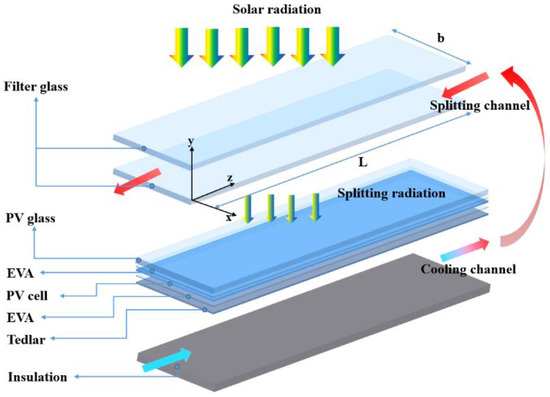
Figure 1.
The sketch of the structure of the hybrid PVT system with separate channel.

Table 1.
Dimensions, thermal and optical properties of used elements.
2.2. Coupled Optical-Thermal Simulation Method
2.2.1. Optical Model
The ideal optical filter for the m-Si PV cell is characterized by Equation (1) [34]. In the present work, the optical properties of the splitting liquid were assumed to be that of the stated ideal optical filter. The spectral absorptivity (αλ) should be 0 for the spectral response range of 380–1100 nm and 1 for the rest band. It was designed to absorb the underutilized spectrum of the PV module.
We adopted a formal expression for the optical characterization of splitting NF to simplify our calculations in this study. The MCRT approach is a ray-tracing methodology for analyzing the optical interaction between physical components. For realizing the MCRT, a commercial ray-tracing software, Tracepro, was used.
2.2.2. Thermal and Electrical Model
The numerical heat transfer computation was implemented using the ANSYS Workbench 2022R1 platform with the concentrated non-uniform solar flux distribution to simulate the PVT hybrid system. The following assumptions are involved in the model:
- The solar intensity can be considered as steady and the constant state study is conducted;
- 3-D fluid flow and heat transfer;
- The NF flow is laminar, uniform, incompressible, and single phase;
- The thermal properties of NFs and used materials are temperature independent;
- The effects of thermal contact resistance and gravitational force are ignored;
- The top surface of the primary glass of components is exposed to free convection, while the bottom surface and side walls of the silicon layer are adiabatic.
By applying the above assumptions, the continuity, momentum, and energy governing equations can be given as follows [29].
Continuity:
Momentum:
Energy in the NF flow:
Energy in the solid parts and silicon substrate:
where Sh(R) and Sh(el) mean the volumetric source of absorbed radiation at each substrate and output electric power, respectively.
In the analysis, the thermal ηth and photoelectric ηel conversion efficiencies can be applied to assess the NF-CPV/T system performance, and they are determined by the following Equations (2) and (3), respectively:
where Eth is the absorbed thermal energy by the NF; c, ρ, Q, are the specific heat capacity, the density, and the flow rate, respectively; Tout and Tin are the outlet temperature and inlet temperature of the splitting NF, respectively; C is the concentration ratio; Ac equals to the area of the PV cell; and Isun is the solar intensity.
where Eel is the electric output of the PV module at the temperature Tcell; δ is the temperature coefficient of PV efficiency (assuming the temperature coefficient of mono-silicon cell is equal to 0.43%); FF is the fill factor which is defined as the ratio of the maximum power that can be delivered by a cell to the product of its short-circuit photocurrent Jsc and open-circuit photovoltage Voc; and ηref is the photoelectric conversion efficiency of PV cell at the reference temperature Tref. The total energy efficiency of the hybrid system is obtained by:
As the values of heat and electricity are different and depend strongly on the application, a total effective exergy efficiency can be defined as:
where w is a weight coefficient that converts the thermal energy to an equivalent amount of electricity and reflects the worth of thermal energy relative to that of electricity. The relative value of heat and electricity in a hybrid system depends on the temperature of the heat output. The coefficient changes in different applications. However, in this paper, we applied a simplified evaluation model and discussed only the output characteristics of the system with respect to the operating flow rate. Herein, w is assumed to be 0.3 [29].
The ambient temperature of the simulation was 300 K and the flow rates of the NF were 17.9712 L/h, 21.3408 L/h, 28.08 L/h, 33.696 L/h, and 40.435 L/h, respectively. The SIMPLE algorithm was used for the pressure-velocity coupling, and the discretization was implemented with a second-order upwind scheme. Furthermore, the convergence criteria were selected to be <10−3 for continuity and momentum equations and <10−6 for energy equations. A grid-independence study was conducted to make the solution independent of the grid size (Table 2). The number of elements varied between 52,380–511,212, and the pressure drop and outlet temperature of splitting NF were calculated. Therefore, 511,212 elements were selected for further analysis. The swept meshing method is employed to generate the model grid as presented in Figure 2.

Table 2.
Grid independency study for the model.
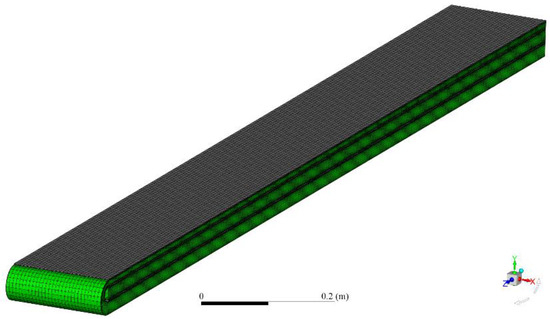
Figure 2.
The selected 3D grid of the hybrid PVT system.
The concentrated non-uniform solar flux distribution on the PV module was simulated by the MCRT method. The flow and heat transfer of NF and the heat conduction through the solid part were simulated by the FVM. It is worth mentioning that the non-uniform solar flux distribution provided by the MCRT is delivered to FVM, serving as an important boundary condition for the flow and heat transfer simulation, which is realized by using UDFs (user-defined functions) in the ANSYS Workbench 2022R1 platform.
3. Results and Discussion
3.1. Optical Analysis
The purpose of the optical study is to determine the realistic energy flux distribution that is received by the PV module. In the present work, the reflector surfaces are specified to have 100% internal reflectance, and the PV module is assumed to be a perfect receiver. Additionally, to evaluate the non-uniformity of the focused light onto the upper surface of the receiver, direct solar beams usually fall into the domain at 1000 W/m2. The design parameters of the CPC concentrator are summarized in Table 3.

Table 3.
Dimensional parameters of the CPC structure.
The traced rays with a sun source with 1000 W/m2 DNI and a 0° incidence angle are depicted in Figure 3a (i.e., rays are normal to the aperture of the CPC concentrator). However, for better visualization, just 1000 rays are displayed. Figure 3b illustrates the corresponding energy flux map (b) on the receiver surface. As can be seen from the figure, the concentrated solar energy flux shows a fairly uniform distribution trend along the receiver length (z). In contrast, the opposite is true along the receiver width (x). It should be emphasized that to improve the computational efficiency, we did not simulate the energy flux distribution of the proposed system in full size, shown in Table 1, but only a partial component is completed. In the subsequent calculation, only the energy flow distribution on the X-axis section of the PV module is applied.

Figure 3.
Traced rays for the developed optical model (a) and corresponding energy flux on the receiver surface (b).
A ray independence analysis is performed using 50,000, 100,000, and 500,000 rays to ensure that the local flux intensity at the receiver does not exactly fluctuate with the number of rays traced. The fluctuation in local flux intensity over the receiver width when tracing 50,000, 100,000, and 500,000 rays are depicted in Figure 4. As can be observed, the flux intensity fluctuates slightly while tracing 50,000 rays as compared to that while tracing 100,000 rays. However, the local flux intensity remains relatively constant when the number of rays is increased from 100,000 to 500,000. Accordingly, 500,000 rays are chosen and set for later research.
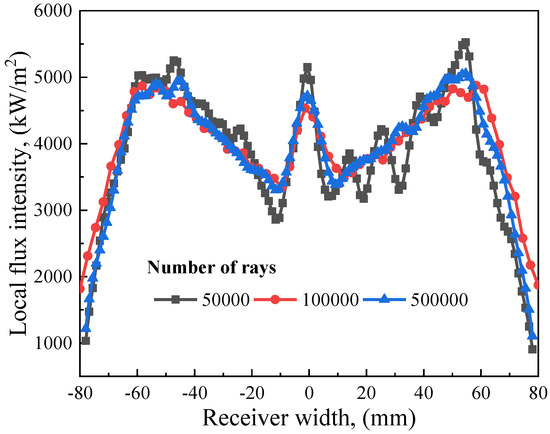
Figure 4.
Ray independence test with 50,000, 100,000, and 500,000 rays.
The distribution of concentrated solar energy flux is affected by the relative position of the concentrator and receiver. Herein, three different cases for the relative positions of the underside of the concentrator and the upper surface of the receiver were considered: (1) case 1: 0 mm, (2) case 2: 12 mm, (3) case 3: 19 mm. In addition, the uniform concentrated solar energy flux is selected as the comparative one, marked as case 4. The analyses are carried out separately for the four designed cases. Figure 5 illustrates the influences of the relative positions of the underside of the concentrator and the upper surface of the receiver on the non-uniformity of the concentrated light on the surface of the receiver. In general, the total energy flux presents as an M-shaped intensity distribution. For case 1, the concentrated energy flux is focused in a narrower region at the center of the receiver and has a higher flux intensity compared with case 2 and case 3. As the relative distance between the receiver and the concentrator increases, the distribution of the concentrated energy flux on the receiver surface becomes more expansive, and the energy flux intensity at the central region gradually decreases. For case 3, the concentrated energy flux distribution covers the entire receiver surface with good uniformity, and the average energy flux intensity is approximately equal to 3990 W/m2.
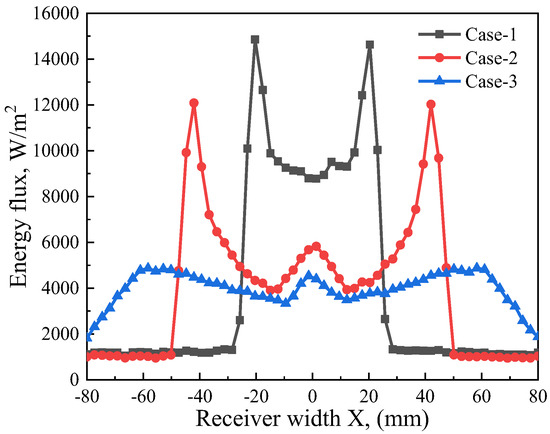
Figure 5.
The concentrated energy flux on the surface of the receiver.
3.2. Thermal Analysis
The thermal analysis involved the determination of PV cell temperature as well as the hermos-electric properties of the PVT hybrid system as a function of NF volume flow. The analysis has been carried out under uniform and non-uniform solar flux distributions.
For validating the present thermal model, the obtained cell temperature is compared with the experimental findings of our team, which is obtained through the experiment rig as shown in Figure 6. The PV/T system consisted of two parts: a CPC concentrator and a PV module integrating the splitting channel. The CPC was fixedly placed above the PV module. Therein, the geometric concentration ratio (CR) was designed as 4 and the concentrating efficiency was approximately 87.5%. The present thermal results are compared with the experimental results [35] in Table 4, which justifies the employed thermal simulation procedure.

Figure 6.
Experiment rig of the PVT hybrid system in the outdoor environment [35].

Table 4.
Comparisons of the predicted results and the experimental values [35].
Figure 7 shows the comparison results of temperature contours of the PV module under three cases of non-uniform concentrated energy flux and one case of a uniform one. Apparently, the non-uniform distribution of the solar concentrated energy flux results in significant differences in the internal temperature distribution of the PV modules. With the increasing non-uniformity of the solar-concentrated energy flux, the temperature difference inside the PV module is gradually augmented. At this time, the high-temperature region is mainly focused at the center of the PV module. For case 1, the maximum temperature inside the PV module can be up to 369.99 K, which is much higher than the normal average heating temperature of the PV cell. It is worth pointing out that this situation can lead to irreversible high-temperature damage to the PV module for the actual operating PV experiment duel. On the other hand, as the uniformity of the concentrated energy flux on the PV module surface is improved, the temperature difference of the PV module in the direction perpendicular to the NF flow gradually becomes smaller. Comparing case 3 and case 4, a similar temperature distribution is presented on the surface of the PV module. The two cases have approximately equal maximum temperatures of 347.81 K and 347.69 K, respectively. Contrasting four cases, the average temperatures of the PV modules are almost equivalent, as well as the NF output temperature. Accordingly, when ignoring the high-temperature damage of the PV modules, the thermal output of the PVT hybrid system will barely be affected by the non-uniform solar concentrated energy flux. Above the analysis shows that rational optimization of solar concentrated energy flux distribution is of great significance to the electrical power output of PV modules.

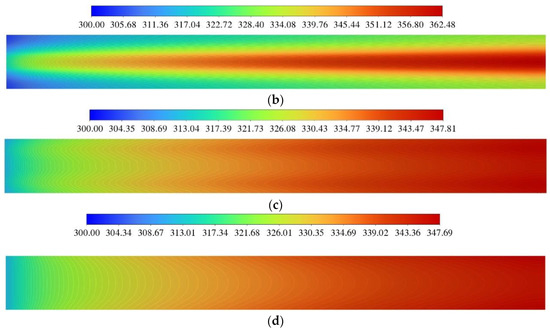
Figure 7.
Comparison of temperature contours of PV module of case 1 (a), case 2 (b), case 3 (c), and case 4 (d).
Based on the numerical model of the PVT hybrid system established in the paper, we further analyzed the effect of the volume flow rate on the thermo-electric performance characteristics of the system. The results are shown in Figure 8 below. From the results, it can be seen that the total thermal efficiency of the system increases significantly with the increase in the volume flow rate. In addition, the electrical efficiency is continuously improved as the PV temperature gradually decreases with the rise in the NF volume flow rate. In general, the total energy efficiency of the PVT hybrid system is above 55% and progressively improves with increasing NF volume flow rate. The overall exergy efficiency of the PVT hybrid system exceeds 30%. It can be seen that the concentrating PVT system based on an NF filter has high solar-energy conversion efficiency.
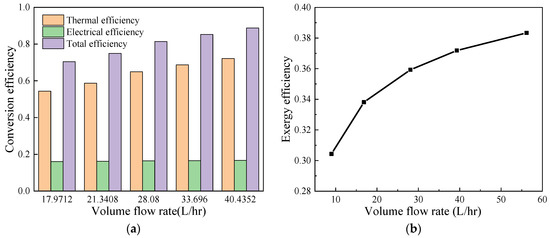
Figure 8.
Conversion efficiency (a) and overall exergy efficiency (b) of PV/T hybrid system as a function of the volume flow rate of the splitting NF.
4. Conclusions
In this study, a detailed 3-D numerical simulation of a splitting NF-based PVT hybrid system under non-uniform concentrated energy flux was carried out. The optical simulation based on MCRT was employed to obtain the realistic energy flux distribution on the receiver. A thermal analysis based on FVM is carried out to determine the thermal output and the cell temperature distribution. The following key conclusions are summarized for the present work:
- (1)
- The distribution of concentrated solar energy flux is dramatically affected by the relative position between the CPC concentrator and receiver. A relatively uniform concentrated solar radiation distribution is obtained in case 3;
- (2)
- The non-uniform concentrated solar energy flux can result in non-uniform temperature profiles of the PV module, which may lead to local overheating. The temperature distribution of the PV module corresponding to case 3 is similar to that of the uniform energy flux;
- (3)
- The PVT hybrid system has high conversion efficiency, with a total conversion efficiency of more than 50%.
Author Contributions
Conceptualization, T.J. and J.L.; Methodology, T.J. and J.L.; Software, M.L.; Validation, M.L.; Formal analysis, M.L.; Investigation, M.L.; Resources, J.L.; Data curation, M.L. and J.L.; Writing—original draft, J.L.; Writing—review & editing, T.J. and J.L.; Supervision, T.J. and J.L. All authors have read and agreed to the published version of the manuscript.
Funding
This research was funded by [Research and application of the key technology of energy storage intelligent heating system based on wind and solar complementary] grant number [20210203210SF] And The APC was funded by [Research and application of the key technology of energy storage intelligent heating system based on wind and solar complementary].
Data Availability Statement
Not applicable.
Conflicts of Interest
The authors declare no conflict of interest.
Nomenclature
| AC | solar receiving area of the PVT system (m2) |
| CR | concentration ratio |
| Cp | specific heat capacity (J/(kg∙K)) |
| Isun | direct solar intensity (W/m2) |
| m | mass flow rate of the fluid filter (kg/s) |
| T | temperature (K) |
| w | average power generation efficiency of thermal power plants |
| Greek symbols | |
| ηel | overall electric efficiency of the D-CPVT system (-) |
| ηth | thermal efficiency of the D-CPVT system (-) |
| ηexe | overall exergy efficiency of the D-CPVT system (-) |
| λ | wavelength (nm) |
| α | absorption |
| Eth is the absorbed thermal energy (W/m2) | |
| Subscripts | |
| th | thermal |
| el | electric |
| t | energy |
| tot | exergy |
| ref | reference |
| Abbreviations | |
| NF | nanofluid |
| CPC | compound parabolic concentrator |
| CPV | concentrating photovoltaic |
| CPVT | concentrating photovoltaic/thermal |
| PVT | photovoltaic/thermal |
References
- Wang, G.; Chao, Y.; Chen, Z. Promoting developments of hydrogen powered vehicle and solar PV hydrogen production in China: A study based on evolutionary game theory method. Energy 2021, 237, 121649. [Google Scholar] [CrossRef]
- Wang, G.; Dong, B.; Chen, Z. Design and behaviour estimate of a novel concentrated solar-driven power and desalination system using S-CO2 Brayton cycle and MSF technology. Renew. Energy 2021, 176, 555–564. [Google Scholar] [CrossRef]
- Açıkkalp, E.; Caliskan, H.; Hong, H.; Piao, H.; Seung, D. Extended exergy analysis of a photovoltaic-thermal (PVT) module based desiccant air cooling system for buildings. Appl. Energy 2022, 323, 119581. [Google Scholar] [CrossRef]
- Bisengimana, E.; Zhou, J.; Binama, M.; Yuan, Y. Numerical investigation on the factors influencing the temperature distribution of photovoltaic/thermal (PVT) evaporator/condenser for heat pump systems. Renew. Energy 2022, 194, 885–901. [Google Scholar] [CrossRef]
- Huang, G.; Wang, K.; Markides, C.N. Efficiency limits of concentrating spectral-splitting hybrid photovoltaic-thermal (PV-T) solar collectors and systems. Light Sci. Appl. 2021, 10, 28. [Google Scholar] [CrossRef] [PubMed]
- Huang, G.; Wang, K.; Curt, S.R.; Franchetti, B.; Pesmazoglou, I.; Markides, C.N. On the performance of concentrating fluid-based spectral-splitting hybrid PV-thermal (PV-T) solar collectors. Renew. Energy 2021, 174, 590–605. [Google Scholar] [CrossRef]
- Wang, G.; Wang, B.; Yuan, X.; Lin, J.; Chen, Z. Novel design and analysis of a solar PVT system using LFR concentrator and nano-fluids optical filter. Case Stud. Therm. Eng. 2021, 27, 101328. [Google Scholar] [CrossRef]
- Bellmann, P.; Wolfertstetter, F.; Conceição, R.; Silva, H.G. Comparative modeling of optical soiling losses for CSP and PV energy systems. Sol. Energy 2020, 197, 229–237. [Google Scholar] [CrossRef]
- Liu, H.; Zhai, R.; Fu, J.; Wang, Y.; Yang, Y. Optimization study of thermal-storage PV-CSP integrated system based on GA-PSO algorithm. Sol. Energy 2019, 184, 391–409. [Google Scholar] [CrossRef]
- Wang, G.; Yao, Y.; Lin, J.; Chen, Z.; Hu, P. Design and thermodynamic analysis of a novel solar CPV and thermal combined system utilizing spectral beam splitter. Renew. Energy 2020, 155, 1091–1102. [Google Scholar] [CrossRef]
- Wang, G.; Zhang, Z.; Chen, Z. Design and performance evaluation of a novel CPV-T system using nano-fluid spectrum filter and with high solar concentrating uniformity. Energy 2023, 267, 126616. [Google Scholar] [CrossRef]
- Atashafrooz, M.; Sajjadi, H.; Delouei, A.A. Simulation of combined convective-radiative heat transfer of hybrid nanofluid flow inside an open trapezoidal enclosure considering the magnetic force impacts. J. Magn. Magn. Mater. 2023, 567, 170354. [Google Scholar] [CrossRef]
- Atashafrooz, M.; Sajjadi, H.; Delouei, A.A. Interacting influences of Lorentz force and bleeding on the hydrothermal behaviors of nanofluid flow in a trapezoidal recess with the second law of thermodynamics analysis. Int. Commun. Heath Mass Transf. 2020, 110, 104411. [Google Scholar] [CrossRef]
- Otanicar, T.; Dale, J.; Orosz, M.; Brekke, N.; DeJarnette, D.; Tunkara, E.; Roberts, K.; Harikumar, P. Experimental evaluation of a prototype hybrid CPV/T system utilizing a nanoparticle fluid absorber at elevated temperatures. Appl. Energy 2018, 228, 1531–1539. [Google Scholar] [CrossRef]
- An, W.; Wu, J.; Zhu, T.; Zhu, Q. Experimental investigation of a concentrating PV/T collector with Cu9S5 nanofluid spectral splitting filter. Appl. Energy. 2016, 184, 197–206. [Google Scholar] [CrossRef]
- Han, X.; Chen, X.; Wang, Q.; Alelyani, S.M.; Qu, J. Investigation of CoSO4-based Ag nanofluids as spectral beam splitters for hybrid PV/T applications. Sol. Energy 2019, 177, 387–394. [Google Scholar] [CrossRef]
- Hashemian, M.; Jafarmadar, S.; Khalilarya, S.; Faraji, M. Energy harvesting feasibility from photovoltaic/thermal (PV/T) hybrid system with Ag/Cr2O3-glycerol nanofluid optical filter. Renew. Energy 2022, 198, 426–439. [Google Scholar] [CrossRef]
- Brekke, N.; Dale, J.; DeJarnette, D.; Hari, P.; Orosz, M.; Roberts, K.; Tunkara, E.; Otanicar, T. Detailed performance model of a hybrid photovoltaic/thermal system utilizing selective spectral nanofluid absorption. Renew. Energy 2018, 123, 683–693. [Google Scholar] [CrossRef]
- Yazdanifard, F.; Ameri, M.; Taylor, R. Parametric investigation of a nanofluid-NEPCM based spectral splitting photovoltaic/thermal system. Energy Convers. Manag. 2021, 240, 114232. [Google Scholar] [CrossRef]
- Ju, X.; Liu, H.; Pei, M.; Li, W.; Lin, J.; Liu, D.; Ju, X.; Xu, C. Multi-parameter study and genetic algorithm integrated optimization for a nanofluid-based photovoltaic/thermal system. Energy 2023, 267, 126528. [Google Scholar] [CrossRef]
- Fuqiang, W.; Zhexiang, T.; Xiangtao, G.; Jianyu, T.; Huaizhi, H.; Bingxi, L. Heat transfer performance enhancement and thermal strain restrain of tube receiver for parabolic trough solar collector by using asymmetric outward convex corrugated tube. Energy 2016, 114, 275–292. [Google Scholar] [CrossRef]
- Kazemian, A.; Salari, A.; Hakkaki-Fard, A.; Ma, T. Numerical investigation and parametric analysis of a photovoltaic thermal system integrated with phase change material. Appl. Energy 2019, 238, 734–746. [Google Scholar] [CrossRef]
- Ebrahim Ghasemi, S.; Akbar Ranjbar, A. Numerical thermal study on effect of porous rings on performance of solar parabolic trough collector. Appl. Therm. Eng. 2017, 118, 807–816. [Google Scholar] [CrossRef]
- Cheng, Z.-D.; He, Y.-L.; Wang, K.; Du, B.-C.; Cui, F. A detailed parameter study on the comprehensive characteristics and performance of a parabolic trough solar collector system. Appl. Therm. Eng. 2014, 63, 278–289. [Google Scholar] [CrossRef]
- Wang, F.; Shuai, Y.; Tan, H.; Yu, C. Thermal performance analysis of porous media receiver with concentrated solar irradiation. Int. J. Heat Mass Transf. 2013, 62, 247–254. [Google Scholar] [CrossRef]
- Wu, Z.; Li, S.; Yuan, G.; Lei, D.; Wang, Z. Three-dimensional numerical study of heat transfer characteristics of parabolic trough receiver. Appl. Energy 2014, 113, 902–911. [Google Scholar] [CrossRef]
- Craig, K.J.; Moghimi, M.A.; Rungasamy, A.E.; Marsberg, J.; Meyer, J.P. Finite-volume ray tracing using Computational Fluid Dynamics in linear focus CSP applications. Appl. Energy 2016, 183, 241–256. [Google Scholar] [CrossRef]
- Ju, X.; El-Samie, M.M.A.; Xu, C.; Yu, H.; Pan, X.; Yang, Y. A fully coupled numerical simulation of a hybrid concentrated photovoltaic/thermal system that employs a therminol VP-1 based nanofluid as a spectral beam filter. Appl. Energy 2020, 264, 114701. [Google Scholar] [CrossRef]
- Abd El-Samie, M.M.; Ju, X.; Xu, C.; Du, X.; Zhu, Q. Numerical study of a photovoltaic/thermal hybrid system with nanofluid based spectral beam filters. Energy Convers. Manag. 2018, 174, 686–704. [Google Scholar] [CrossRef]
- Hu, X.; Xu, T.; Zhou, L.; Wang, Q.; Arıcı, M.; Li, D. Comparison of transmittance and reflection methods for solving optical constants of optical glass. Optik. 2019, 183, 924–932. [Google Scholar] [CrossRef]
- Yuwawech, K.; Wootthikanokkhan, J.; Tanpichai, S. Enhancement of thermal, mechanical and barrier properties of EVA solar cell encapsulating films by reinforcing with esterified cellulose nanofibres. Polym. Test. 2015, 48, 12–22. [Google Scholar] [CrossRef]
- Green M, A. Self-Consistent Optical Parameters of Intrinsic Silicon at 300K including temperature coefficients. Sol. Energy Mater. Sol. Cells 2008, 92, 1305–1310. [Google Scholar] [CrossRef]
- Lin, J.; Liu, S.; Ju, X.; Xu, C.; Ju, X.; Liu, H. Investigation of two-stage concentrating splitting photovoltaic/thermal system with a flexible heat-electricity ratio based on nanofluid. Energy Convers. Manag. 2022, 258, 115531. [Google Scholar] [CrossRef]
- Barthwal, M.; Rakshit, D. Holistic opto-thermo-electrical analysis of a novel spectral beam splitting-based concentrating photovoltaic thermal system. J. Clean. Prod. 2022, 379, 134545. [Google Scholar] [CrossRef]
- Lin, J.; Liu, H.; Ju, X.; Liu, S.; Xu, C.; Ju, X. Investigation of bubbles on the performance of an optical water filter for a photovoltaic/thermal system. Appl. Therm. Eng. 2022, 213, 118643. [Google Scholar] [CrossRef]
Disclaimer/Publisher’s Note: The statements, opinions and data contained in all publications are solely those of the individual author(s) and contributor(s) and not of MDPI and/or the editor(s). MDPI and/or the editor(s) disclaim responsibility for any injury to people or property resulting from any ideas, methods, instructions or products referred to in the content. |
© 2023 by the authors. Licensee MDPI, Basel, Switzerland. This article is an open access article distributed under the terms and conditions of the Creative Commons Attribution (CC BY) license (https://creativecommons.org/licenses/by/4.0/).